Securing Federated Learning
A comprehensive framework to enhance security, reliability, and privacy in Federated Learning systems.
HydraGuard
Hybrid defense against backdoor attacks
SECUNID
Filters out malicious updates in FL
CodeNexa
Prevents Man-in-the-Middle attacks
SHIELD
Protects VFL from label inference attacks
Security Framework for Federated Learning
Federated Learning (FL) facilitates decentralized model training across various clients while safeguarding data privacy, but it poses significant security risks, such as backdoor attacks, poisoning attacks, Man-in-the-Middle (MITM) attacks, and label inference attacks. This research introduces a security framework with four core components, each tailored to mitigate specific threats in FL environments.
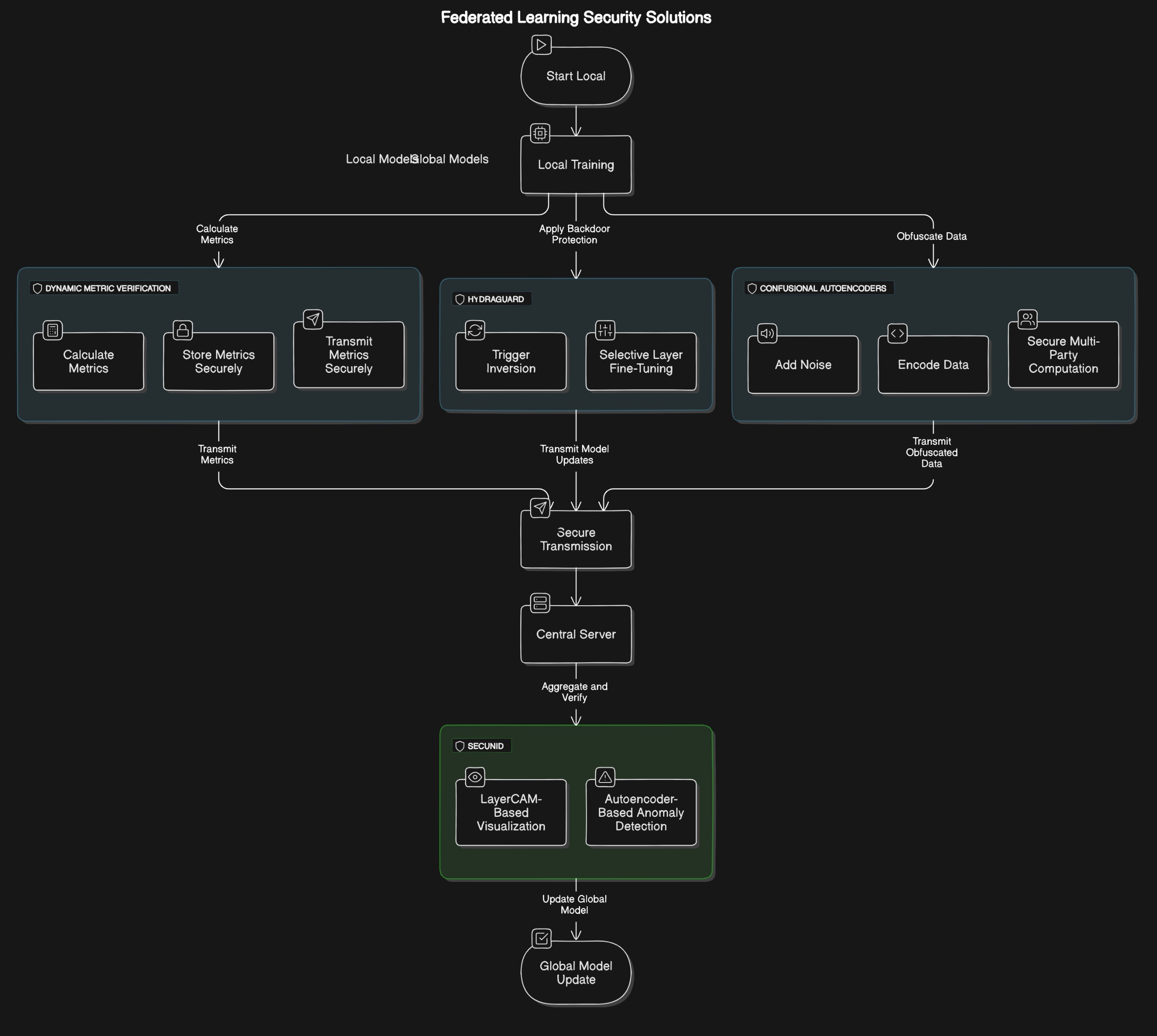
HydraGuard is a hybrid defense against backdoor attacks, combining Trigger Inversion and Simple Tuning methods. Trigger Inversion identifies potential backdoor triggers by reconstructing patterns from model gradients, while Simple Tuning adjusts specific layers of the model to neutralize these threats. This dual approach reduces backdoor attack success rates while maintaining model accuracy.
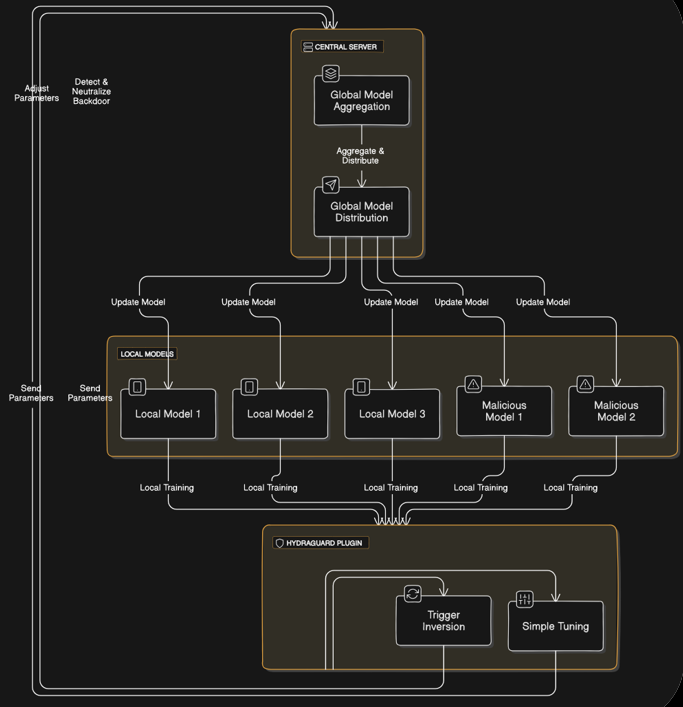
SECUNID addresses data and model poisoning attacks by filtering out malicious updates before they are integrated into the global model. It utilizes LayerCAM, a visual interpretability tool, and an Autoencoder to detect and exclude anomalies, ensuring only legitimate updates contribute to the model.
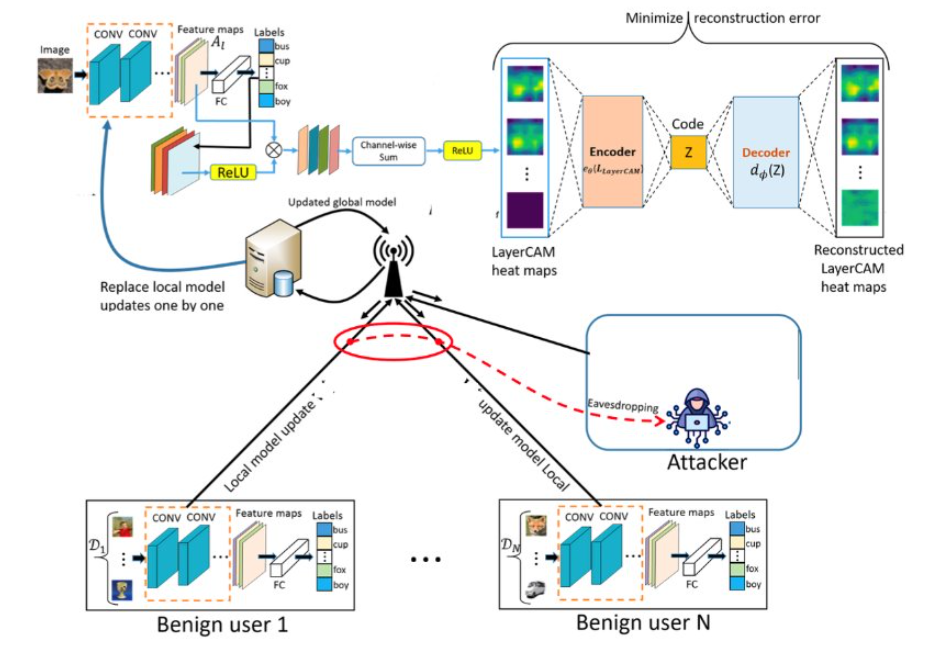
CodeNexa prevents MITM attacks by implementing dynamic metric verification, which encrypts and validates key performance metrics during FL, safeguarding the system from unauthorized alterations during communication.
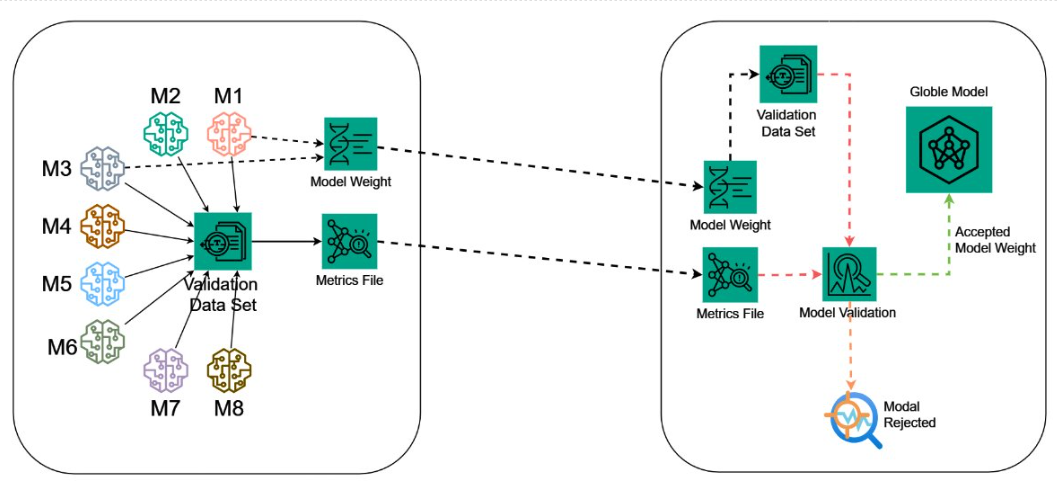
SHIELD protects Vertical Federated Learning (VFL) systems from label inference attacks using confusional autoencoders, noise addition, and a simplified Secure Multi-Party Computation (SMC) framework. These techniques obscure data representations, reducing the risk of sensitive label inference.

Background
Federated Learning (FL) is a revolutionary approach in machine learning that addresses data privacy concerns. Introduced by Google in 2016, FL allows multiple clients to collaboratively train a global model without centralized data storage, ensuring sensitive data remains on the client side.
FL has found significant adoption in industries like healthcare and finance, where data privacy is crucial for compliance with regulations such as HIPAA.
Problem Statement
Code Nexa
Click to see details
Description
Dynamic Nature of Federated Learning (FL). Continuous Model Integrity Verification. Protection Against MITM Attacks
Hydraguard
Click to see details
Description
Continuous attacks are more aggressive than single-shot attacks. Detecting and Rejecting malicious weights leads to data loss, and data breaches and reduces module accuracy. Existing defense mechanisms need big computational power and violate the essence of the FL. Unreliable Predictions.
Secunid
Click to see details
Description
Existing defenses, such as distance-based metrics (e.g., Krum, Trimmed-Mean), struggle to detect sophisticated attacks where malicious updates resemble legitimate ones. Attackers alter their local model updates during training, sending manipulated updates to the central server, which degrades the global model's accuracy and reliability. Current methods usually require some knowledge of the attacks, Malicious participant ratio Examining local datasets (compromise the privacy of participants) Assuming IID data.
SHIELD
Click to see details
Description
Limited Defense Mechanisms: Current VFL security protocols are not robust enough to fully prevent label inference attacks, leading to potential data breaches. Lack of scalable solutions that balance privacy and performance. Insufficient Mitigation Strategies: Existing solutions may not effectively address all types of label inference attacks, especially sophisticated passive and active forms. Existing methods for defending against label inference attacks in VFL are computationally expensive (e.g., Secure Multi-Party Computation). Insufficient focus on lightweight mechanisms for privacy preservation in collaborative learning environments.
Proposed Solution
- 1.
HydraGuard
Mitigates backdoor attacks through trigger inversion and simple tuning, ensuring minimal performance impact.
- 2.
SECUNID
Identifies poisoned data updates using LayerCAM heatmaps and Autoencoders for anomaly detection.
- 3.
CodeNexa
Uses dynamic metric verification and encryption to prevent MITM attacks during model communication.
- 4.
SHIELD
Defends Vertical Federated Learning (VFL) from label inference attacks through confusional autoencoders and noise injection.
Detect and Neutralize Backdoor Attacks
Implementing HydraGuard to identify and mitigate backdoor patterns through trigger inversion and simple tuning.
Mitigate Data and Model Poisoning
Using SECUNID with LayerCAM heatmaps and Autoencoders to filter out compromised model updates.
Secure Model Communication
CodeNexa ensures encrypted data exchange through dynamic metric verification and AES encryption to prevent MITM attacks.
Protect Against Label Inference in VFL
SHIELD utilizes confusional autoencoders and noise injection to secure sensitive data in collaborative environments.
Methodology
The proposed security framework comprises four sub-components, each designed to address specific security threats in Federated Learning.
HydraGuard
Sub Component
Detects backdoor triggers and fine-tunes model layers to remove their effect.
SECUNID
Sub Component
Uses visual interpretability tools like LayerCAM to create heatmaps, analyzed by Autoencoders to identify anomalies.
CodeNexa
Sub Component
Encrypts model updates and validates metrics during transmission to prevent MITM attacks.
SHIELD
Sub Component
Secures VFL systems by obfuscating data using confusional autoencoders and injecting noise to prevent label inference.
Technologies Used

Python

React
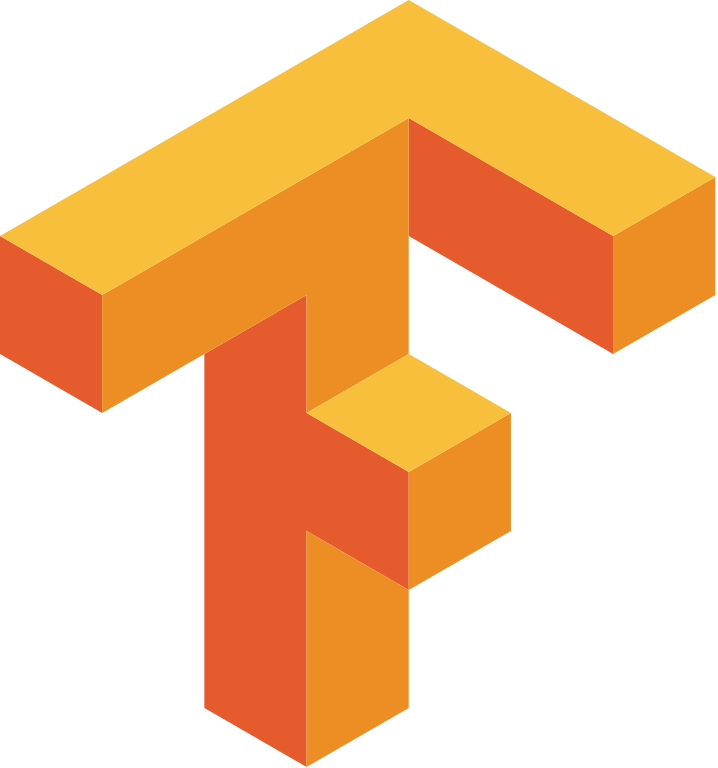
Tensorflow

Keras

MongoDB
VS Code

Google Cloud
GitHub

Docker

Google Colab
Amazon AWS
OpenAI
Timeline in Brief
February 2024
Project Charter & Proposal
Project charter submission followed by proposal presentation and detailed report submission.
Progress: 100
100%May 2024
Progress Presentation I
First progress review including presentation and status documentation.
Progress: 100
100%June 2024
Research Paper
Submission of initial research paper documenting findings and methodology.
Progress: 100
100%September 2024
Progress Presentation II
Second progress review with updated status documentation.
Progress: 100
100%October 2024
Final Presentation & Website
Project website launch and final presentation with viva assessment.
Progress: 90
90%November 2024
Research Documentation
Research paper registration and logbook submission.
Progress: 100
100%December 2024
Final Report
Submission of proofread final report documenting complete project outcomes.
Progress: 100
100%
Downloads
Please find all documents related to this project below.
Our Team

B.L.H.D. Peiris
Team LeaderUniversity: Sri Lanka Institute of Information Technology
Department: Information Systems Engineering

J.P.A.S. Pathmendre
Team MemberUniversity: Sri Lanka Institute of Information Technology
Department: Information Systems Engineering

A.R.W.M.V. Hasaranga
Team MemberUniversity: Sri Lanka Institute of Information Technology
Department: Information Systems Engineering

A.M.I.R.B. Athauda
Team MemberUniversity: Sri Lanka Institute of Information Technology
Department: Information Systems Engineering

Mr. Kanishka Yapa
Supervisor | LecturerUniversity: Sri Lanka Institute of Information Technology
Department: Information Systems Engineering

Mr. Samadhi Rathnayake
Co-Supervisor | LecturerUniversity: Sri Lanka Institute of Information Technology
Department: Information Systems Engineering
Achievements

Our research CodeNEXA : A Novel Security Framework for Federated Learning to Mitigate Man-in-the-Middle Attacks was selected for the IEEE UEMCON Awards 2024 conference, and we have already presented our paper at the event.

Our research paper Project ALVI : Privacy-Driven Defenses Federated Learning Security & Authentication was selected for the ICAC 2024 conference, and we are now ready to present it at the conference.
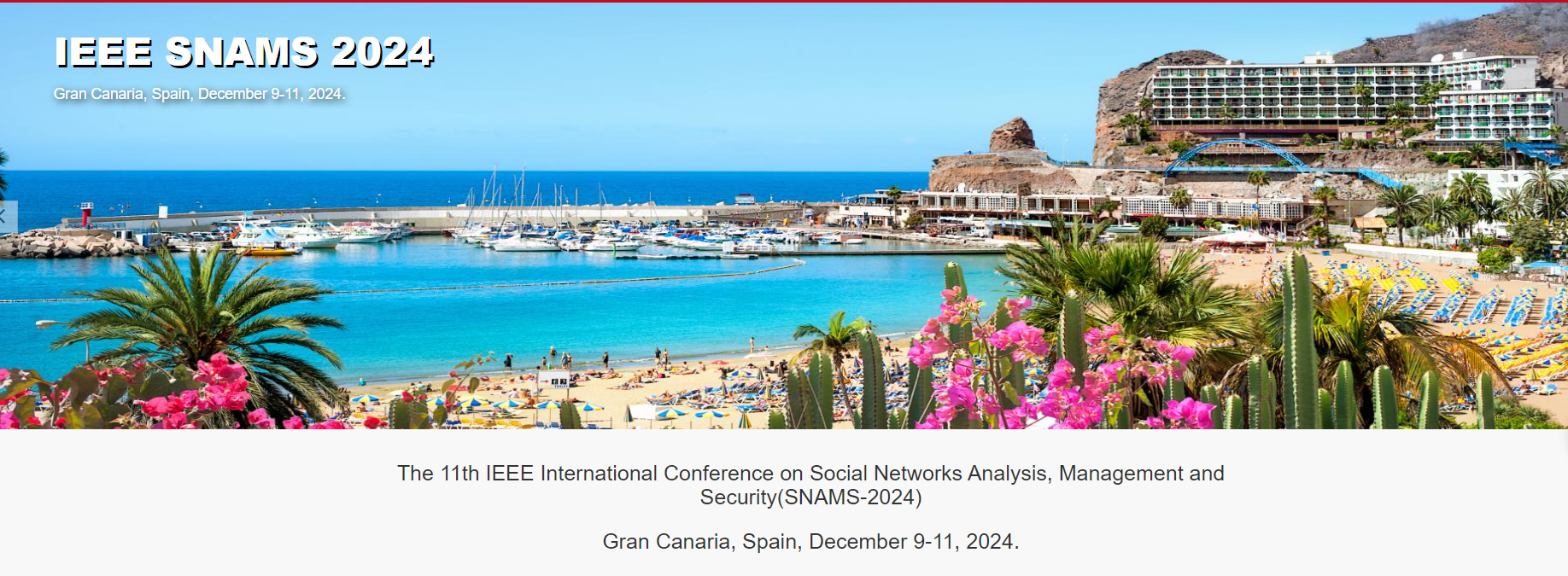
Our research paper HydraGuard: Backdoor immunity in FL Environments was selected for the SNAMS 2024 conference, and we are now ready to present it at the event.
Contact Us
Contact Details
For further queries please reach us at project.alvi@gmail.com
Hope this project helped you in some manner. Thank you!
- Project ALVI Team 👾
